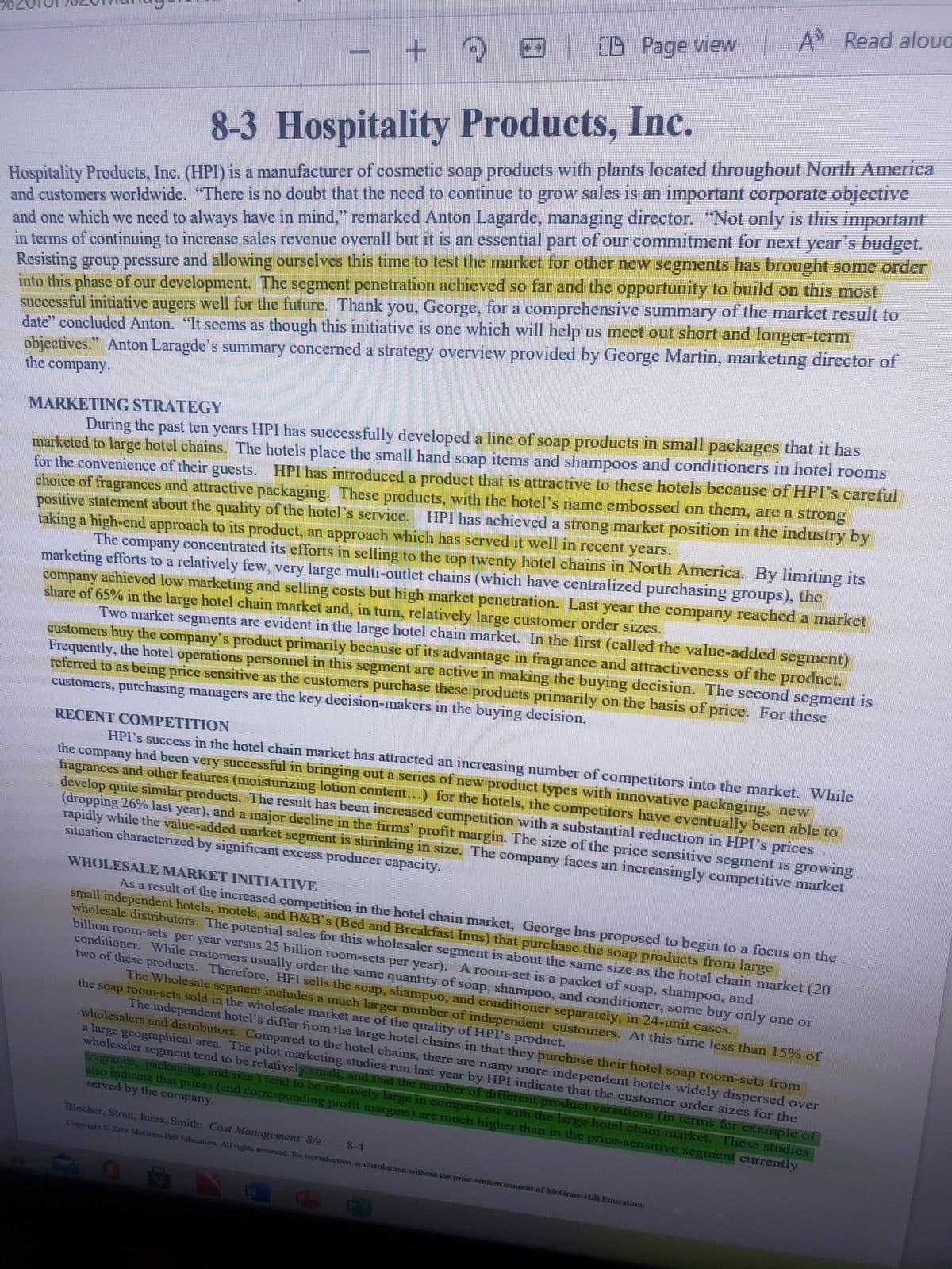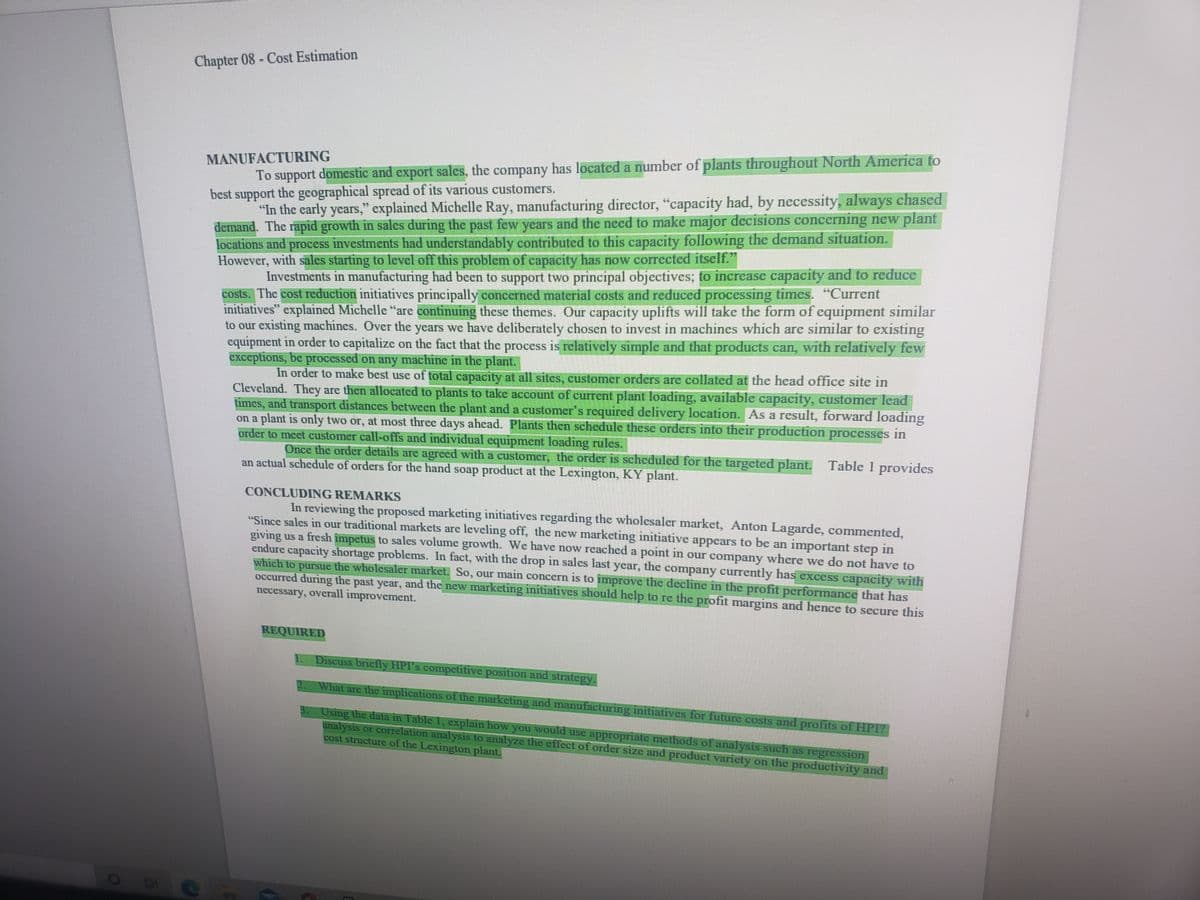Discuss briefly HPI’s competitive position and strategy.
Chapter1: Taking Risks And Making Profits Within The Dynamic Business Environment
Section: Chapter Questions
Problem 1CE
Related questions
Question
8-3 Hospitality Products, Inc.
1.Discuss briefly HPI’s competitive position and strategy.

Transcribed Image Text:A Read alouc
O TG Page view
Hospitality Products, Inc. (HPI) is a manufacturer of cosmetic soap products with plants located throughout North America
and customers worldwide. "There is no doubt that the need to continue to grow sales is an important corporate objective
and one which we need to always have in mind," remarked Anton Lagarde, managing director. "Not only is this important
in terms of contiinuing to inerease sales revenue overall but it is an essential part of our commitment for next year's budget.
Resisting group pressure and allowing ourselves this time to test the market for other new segments has brought some order
into this phase of our development. The segment penetration achieved so far and the opportunity to build on this most
successful initiative augers well for the future. Thank you, George, for a comprchensive summary of the market result to
date" concluded Anton. "It seems as though this initiative is one which will help us meet out short and longer-term
objectives." Anton Laragde's summary concerned a strategy overview provided by George Martin, marketing director of
the company.
8-3 Hospitality Products, Inc.
During the past ten years HPI has successfully developed a line of soap products in small packages that it has
marketed to large hotel chains. The hotels place the small hand soap items and shampoos and conditioners in hotel rooms
for the convenience of their guests. HPI has introduced a product that is attractive to these hotels because of HPI's careful
choice of fragrances and attractive packaging. These products, with the hotel's name embossed on them, are a strong
positive statement about the quality of the hotel's service.
taking a high-end approach to its product, an approach which has scrved it well in recent years.
MARKETING STRATEGY
HPI has achieved a strong market position in the industry by
The company concentrated its efforts in selling to the top twventy hotel chains in North America. By limiting its
marketing efforts to a relatively few, very large multi-outlet chains (which have centralized purchasing groups), the
company achieved low marketing and selling costs but high market penetration. Last year the company reached a market
share of 65% in the large hotel chain market and, in turn, relatively large customer order sizes.
Two market segments are evident in the large hotel chain market. In the first (called the value-added segment)
customers buy the company's product primarily because of its advantage in fragrance and attractiveness of the product.
Frequently, the hotel operations personnel in this segment are active in making the buying decision. The second segment is
referred to as being price sensitive as the customers purchase these products primarily on the basis of price. For these
customers, purchasing managers are the key decision-makers in the buying decision.
RECENT COMPETITION
HPI's success in the hotel chain market has attracted an increasing number of competitors into the market. While
the company had been very successful in bringing out a series of new product types with innovative packaging, new
fragrances and other features (moisturizing lotion content. ..) for the hotels, the competitors have eventually been able to
develop quite similar products. The result has been increased competition with a substantial reduction in HPI's prices
(dropping 26% last year), and a major decline in the firms profit margin. The size of the price sensitive segment is growing
rapidly while the value-added market segment is shrinking in size. The company faces an increasingly competitive market
situation characterized by significant excess producer capacity.
WHOLESALE MARKET INITIATIVE
As a result of the increased competition in the hotel chain market, George has proposed to begin to a focus on the
small independent hotels, motels, and B&B's (Bed and Breakfast Inns) that purchase the soap products from large
wholesale distributors. The potential sales for this wholesaler segnment is about the same size as the hotel chain market (20
billion room-sets per year versus 25 billion room-sets per year). A room-set is a packet of soap, shampoo, and
conditioner. While customers usually order the same quantity of soap, shampoo, and conditioner, some buy only one or
two of these products. Therefore, HFI sells the soap, shampoo, and conditioner separately, in 24-unit cases.
The Wholesale segment includes a much larger number of independent customers. At this time less than 15% of
the soap room-sets sold in the wholesale market are of the quality of HPI's product.
The independent hotel's differ from the large hotel chains in that they purchase their hotel soap room-sets from
wholesalers and distributors. Compared to the hotel chains, there are many more independent hotels widely dispersed over
a large geographical area. The pilot marketing studies run last year by HPI indicate that the customer order sizes for the
wholesaler segment tend to be relatively small, and that the number of different product variations (in terms for example of
fragrance, packaging, and size) tend to be relatively large in comparison with the large hotel chain market. These studies
also indicate that prices (ad corresponding profit margins) are much higher than in the price-sensitive segment currently
served by the company.
Blocher, Stout, Juras, Smith: Cost Management 8/e
8-4
Copyright 2018 McCrw-Hill Education All rights reserved. No reproduction or distribution without the prior written consent of McGraw-Hill Education.

Transcribed Image Text:Chapter 08- Cost Estimation
To support domestic and export salcs, the company has located a number of plants throughout North America to
best support the geographical spread of its various customers.
MANUFACTURING
"In the early years," explained Michelle Ray, manufacturing director, "capacity had, by necessity, always chased
demand. The rapid growth in sales during the past few years and the need to make major decisions concerning new plant
locations and process investments had understandably contributed to this capacity following the demand situation.
However, with sales starting to level off this problem of capacity has now corrected itsclf.
44
Investments in manufacturing had been to support two principal objectives; to increase capacity and to reduce
costs. The cost reduction initiatives principally concerned material costs and reduced processing times. "Current
initiatives" explained Michelle “are continuing these themes. Our capacity uplifts will take the form of equipment similar
to our existing machines. Over the years we have deliberately chosen to invest in machines which are similar to existing
equipment in order to capitalize on the fact that the process is relatively simple and that products can, with relatively few
exceptions, be processed on any machine in the plant.
In order to make best usc of total capacity at all sites, customer orders arc collated at the head office site in
Cleveland. They are then allocated to plants to take account of current plant loading, available capacity, customer lead
times, and transport distances between the plant and a customer's required delivery location. As a result, forward loading
on a plant is only two or, at most three days ahead. Plants then schedulc these orders into their production processes in
order to meet customer call-offs and individual equipment loading rules.
Once the order details are agreed with a customer, the order is scheduled for the targeted plant. Table 1 provides
an actual schedule of orders for the hand soap product at the Lexington, KỲ plant.
CONCLUDING REMARKS
In reviewing the proposed marketing initiatives regarding the wholesaler market, Anton Lagarde, commented,
"Since sales in our traditional markets are leveling off, the new marketing initiative appears to be an important step in
giving us a fresh impetus to sales volume growth. Wc have now reached a point in our company where we do not have to
endure capacity shortage problems. In fact, with the drop in sales last year, the company currently has exccss capacity with
which to pursSue the wholesaler market. So, our main concern is to improve thc decline in the profit pcrformance that has
occurred during the past year, and the new marketing initiatives should help to rc thc profit margins and hence to secure this
necessary, overall improvement.
REQUIRED
Discuss briefly HPI's competitive position and strategy.
What are the implications of the marketing and manufacturing initiatives for future.costsand profits of HPI
Using the data in Table 1, explain how you would use appropriate methods of analysis such as regrcssion)
analysis or correlation analysis to analyze the effect of order size and product varicty on the productivity and
cost structure of the Lexington plant.
Expert Solution
This question has been solved!
Explore an expertly crafted, step-by-step solution for a thorough understanding of key concepts.
This is a popular solution!
Trending now
This is a popular solution!
Step by step
Solved in 2 steps

Knowledge Booster
Learn more about
Need a deep-dive on the concept behind this application? Look no further. Learn more about this topic, management and related others by exploring similar questions and additional content below.Recommended textbooks for you

Understanding Business
Management
ISBN:
9781259929434
Author:
William Nickels
Publisher:
McGraw-Hill Education

Management (14th Edition)
Management
ISBN:
9780134527604
Author:
Stephen P. Robbins, Mary A. Coulter
Publisher:
PEARSON

Spreadsheet Modeling & Decision Analysis: A Pract…
Management
ISBN:
9781305947412
Author:
Cliff Ragsdale
Publisher:
Cengage Learning

Understanding Business
Management
ISBN:
9781259929434
Author:
William Nickels
Publisher:
McGraw-Hill Education

Management (14th Edition)
Management
ISBN:
9780134527604
Author:
Stephen P. Robbins, Mary A. Coulter
Publisher:
PEARSON

Spreadsheet Modeling & Decision Analysis: A Pract…
Management
ISBN:
9781305947412
Author:
Cliff Ragsdale
Publisher:
Cengage Learning

Management Information Systems: Managing The Digi…
Management
ISBN:
9780135191798
Author:
Kenneth C. Laudon, Jane P. Laudon
Publisher:
PEARSON

Business Essentials (12th Edition) (What's New in…
Management
ISBN:
9780134728391
Author:
Ronald J. Ebert, Ricky W. Griffin
Publisher:
PEARSON

Fundamentals of Management (10th Edition)
Management
ISBN:
9780134237473
Author:
Stephen P. Robbins, Mary A. Coulter, David A. De Cenzo
Publisher:
PEARSON